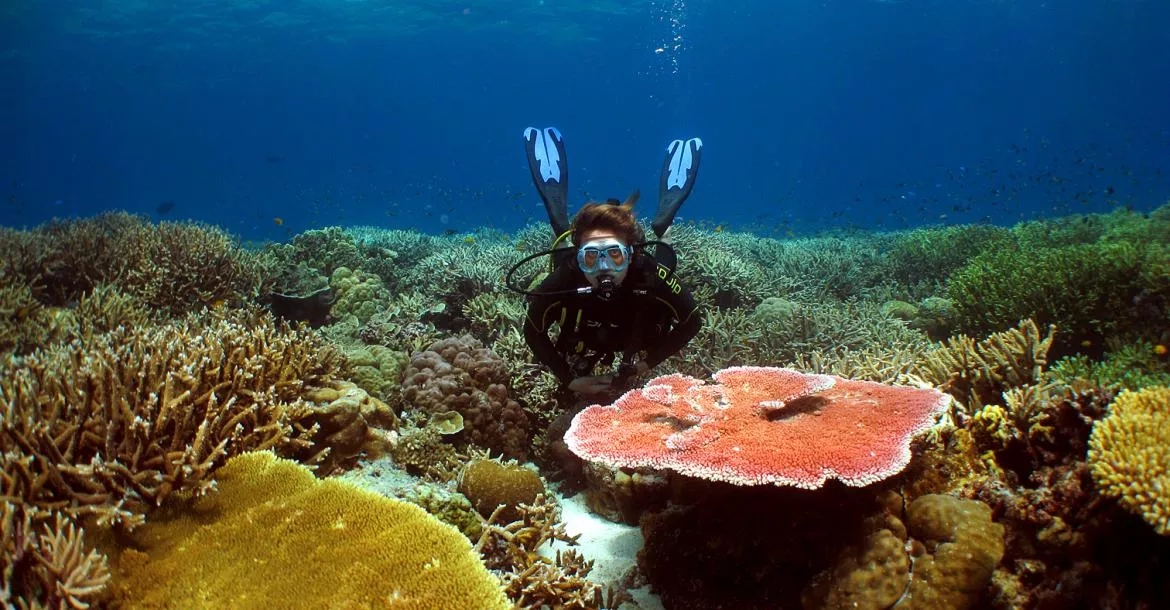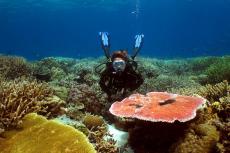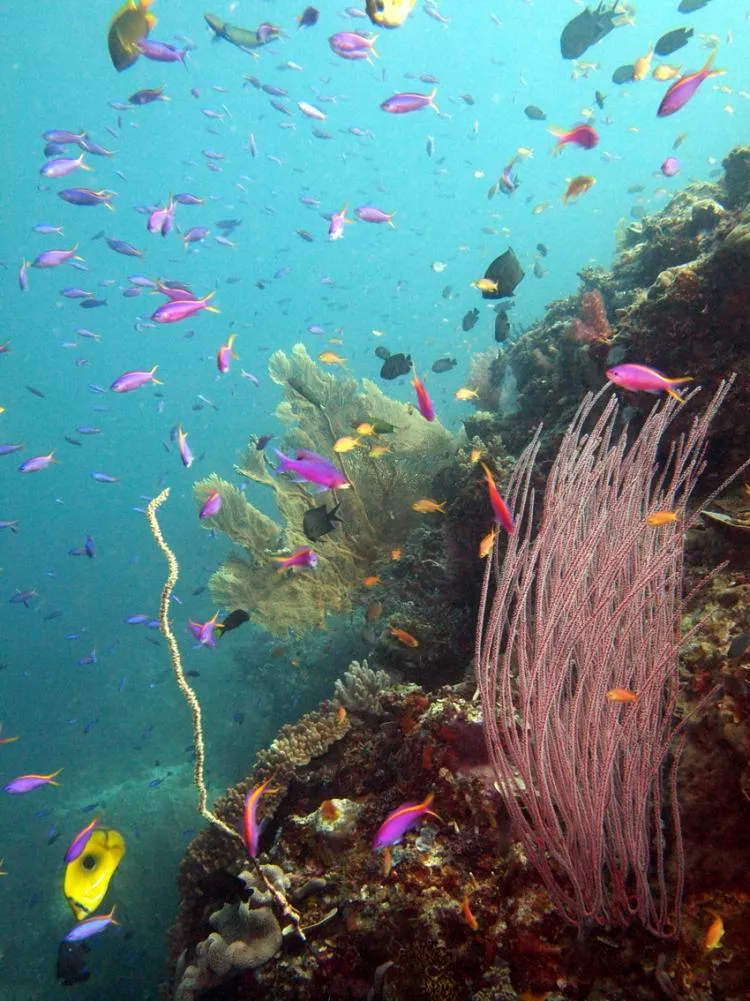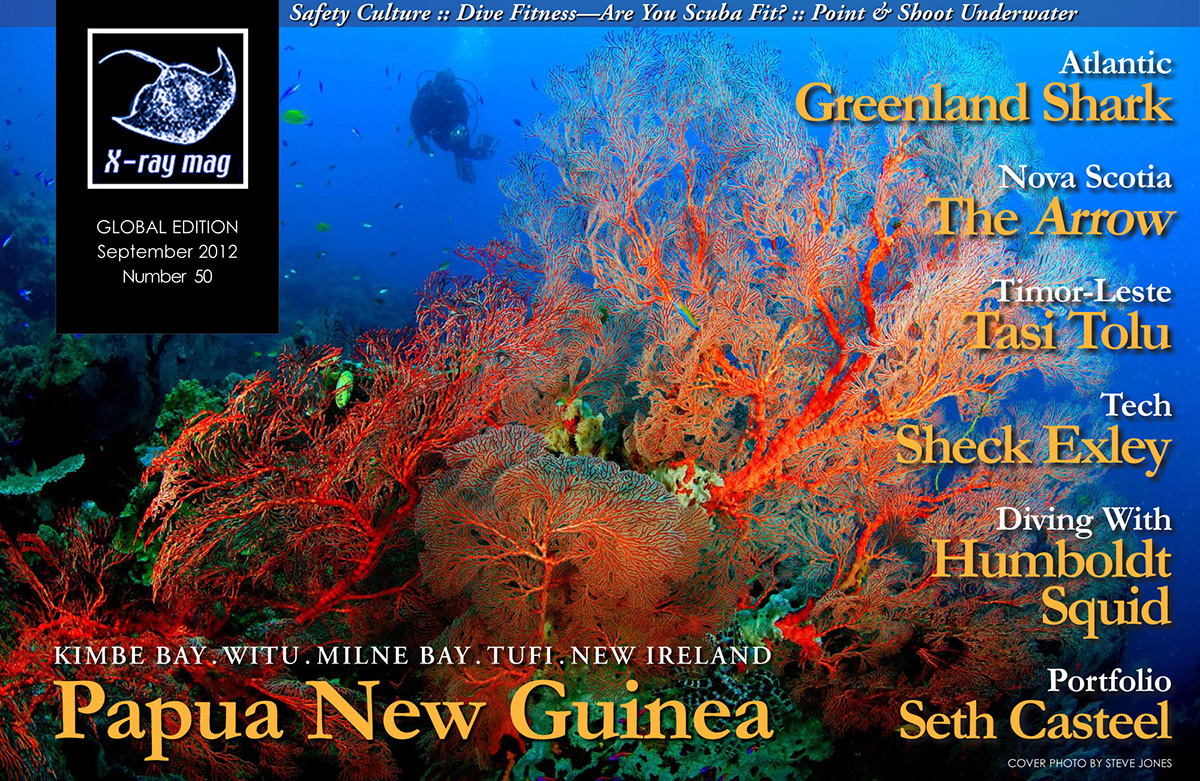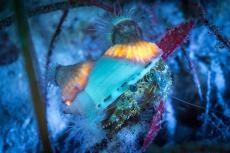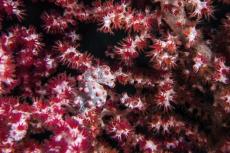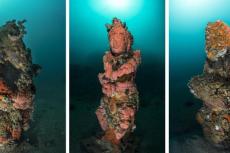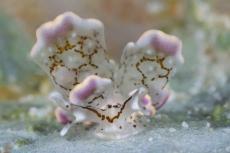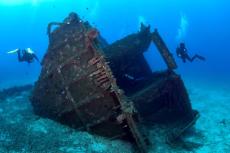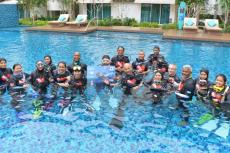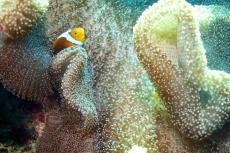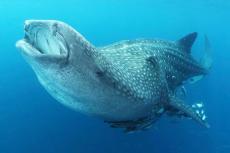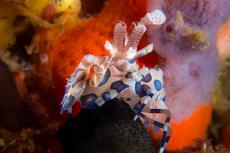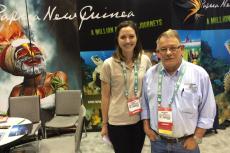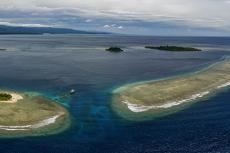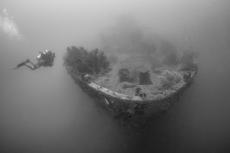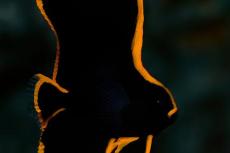Is there another country anywhere with so much diversity? The six million inhabitants of this nation of mountains and islands are spread over 463,000km2 of mountainous tropical forests and speak over 800 different languages (12 percent of the world total). Papua New Guinea occupies half of the third largest island in the world as well as 160 other islands and 500 named cays.
Contributed by
Located just south of the Equator and to the north of Australia, Papua New Guinea (PNG) is a diver’s paradise with the fourth largest surface area of coral reef ecosystem in the world (40,000km2 of reefs, seagrass beds and mangroves in 250,000km2 of seas), and underwater diversity with 2,500 species of fish, corals and molluscs.
There are more dive sites than you can shake a stick at with many more to be discovered and barely a diver on them. The dive centres are so far apart that there is only ever one boat at any dive site.
It is one of the few places left in the world where a diver can see macro critters, pelagics and big stuff as well as fantastic soft and hard corals. The often misused and abused adjective, ‘pristine’, is actually appropriate here due to low fishing pressure in the area in comparison to other areas of the Coral Triangle, no dynamite fishing and a system implemented by dive resorts whereby local reef owners receive a small fee for every diver who visit their reef. As a result, elders make sure that the reefs are not fished.
So, where to go? We set off on a four-resort tour to the north and the south taking in the provinces of Milne Bay, Oro and New Ireland.
Tufi
Sitting at the back of the De Havilland Twin Otter with my partner, Imi, and an American Mom-Dad-and-teenage-son-combo in front, I peered through the misty clouds at the swath of trees below, occasionally cut by the hairline crack of a path or the meandering swirls of a river.
The jagged peaks of the Owen-Stanley range that run down the spine of the island weren’t that far away, as we headed east from Port Moresby to Tufi. The landscape was rugged to say the least, and it was easy to understand why both Australian and Japanese troops had struggled during the Second World War battles there.
As we approached the east coast of Oro Province, the spectacular fjords of Cape Nelson came into view—a strange mix of glacial action now topped by lush tropical forest, with aqua coral reefs surrounding the headlands clearly visible in the cobalt blue of the Solomon Sea. Banking steeply, we lined up with the gravel airstrip and touched down. Two 4WD vehicles were waiting for us to take us on the one-minute drive to the resort.
With a fruit juice in hand, we whizzed through the usual paperwork and were asked to leave our dive gear outside our rooms in 20 minutes and meet at the reception area from where we were taken down to the dive centre. Less than 90 minutes after landing, the five of us plus instructor Glen and dive master Alex were in a boat and heading off across the flat sea to Bev’s Reef—part of the mid-distance reef system and one of the several Tufi reefs with a manta cleaning station. Using a well-drawn dive site map, Glen laid out the plan for a drift dive, and off we went.
Bev’s Reef. Imi hadn’t dived for four months, and I had the new camera, so we were planning on just chilling and getting comfortable again—a wall dive seemed ideal. Rolling in, we both burst into grins not just from the simple pleasure of being in the water again, but because of the clear blue water filled with corals, reef fish and colourful purple, yellow and white sea squirts. There were nudibranchs and schools of fusiliers and snappers, whitetip reef sharks and three of the nine species of anemonefish found in PNG.
Wending our way slowly at the back of the group, coming over the top of a coral outcrop to have a gander for big stuff that might be hanging out in the current, I had to do a double take. Sitting there next to a crinoid was one of PNG’s underwater grails—a black Merlet’s or lacy scorpionfish (Rhinopias aphanes) which has the peculiar habit off shedding its skin every three months or so. Photographers search for these for days and days, and here I was pointing an unfamiliar camera at one after barely 30 minutes in the water. It turned out to be the first of two that I saw, but it was the start of a long list of new sightings for me.
Veale’s Reef. One of Tufi’s signature sites is Veale’s Reef, often dived on the same trip as Bev’s. Veale’s is often frequented by an albino hammerhead, but not on this occasion. Still, it was hard to grumble with all the schools of baitfish, barracuda, black and white snapper, batfish, some Spanish mackerel, as well as a swift-moving green turtle and a couple more whitetips swimming around. We certainly had enough to talk about over a late but delicious lunch on the veranda.
Blue Ribbon Reef. Some reefs are just a short trip away, such as Blue Ribbon Reef just round the runway headland, which we dived during a tropical storm. The sea turned an atmospheric deep blue as we searched for, you guessed it, ribbon eels. Not all ribbon eels are blue—far from it, in fact. They are all born black with a yellow dorsal stripe; adult females are yellow with a black anal fin with white margins on the fins, and only adult males are blue with a yellow dorsal fin.
Outer reefs. The outer reefs are a 30-minute boat ride away, and Cyclone Reef is one of them. The story goes that it appeared from nowhere after a severe storm in 1972, brought up from the depths by the elements. Its very top breaks the surface of the sea and is a haven for mating seabirds. Over the edge, it drops away into a wall dive, once again buzzing with reef life, and out in the blue, we spied two hammerhead sharks cruising past.
Minor Reef is nearby and often dived in tandem with Cyclone. The reef top sits a few metres below the surface, and its plate and staghorn corals bask in the sunlight illuminating the damselfish that adorn them, making it a great spot for no-flash photography. It is named after the large bright yellow and black Notodoris minor nudibranch that is often found there.
Back at the resort, looking at the maps on the walnut-panelled walls gives one a better sense of the remoteness and the size of the area. Whole swathes of the Solomon Sea, starting where Cyclone and Minor Reefs are marked, are uncharted. There are basically reefs everywhere out there.
Jack Daniels and Nuggets are two recently discovered reefs, and Glen and his brother, Archie, were keen to get us out to them. Armed with a small plastic bottle with a little water in it, Archie began crunching and rolling it between his hands as soon as we were down Jack Daniel’s slope and onto the wall. Within a couple of minutes, he had attracted the attention of four grey reef sharks. They didn’t seem very used to human interaction and kept their distance, as did a couple of sea turtles. The sharks occasionally darted a bit closer to recce us odd-looking, large, bubble-blowing creatures, and a couple of whitetip reef sharks came by for a look, too.
With our appetites for diving well and truly whetted, we went for an afternoon dive off the public wharf. It is talked up as a photographer’s delight and one of the best spots in the world for so-called muck-diving. Muck-diving gets its name from apparently uninteresting sites that can be either silty, sandy, muddy or just rather barren-looking, but are actually home to a large number of small, weird and wonderful creatures.
Tufi Wharf. Tufi’s wharf dive site is more of a junk dive than a muck dive. The sloping wall of the fjord is littered with debris from the harbour’s previous life as a torpedo patrol boat base during WWII, dumping of old bits of machinery, the odd fuel drum and some girders, which were no doubt formerly part of the jetty. There are also the remains of a PT boat and its torpedoes down at 45 metres.
However, there was more than enough along the fjord slope and wall to keep us occupied, with ornate and robust ghostpipefish, frogfish, ringed pipefish, common seahorse, loads of nudibanchs, crab-eye gobies, anemonefish, mantis shrimp, cleaner shrimp and lionfish to gander at. Plus, 50 metres past the remains of the torpedo boat wharf were more walls, little caves and tons of sponges on the corner of the harbour.
If you fancy a fourth dive in a day, dusk dives are available, and Alex and Archie—the eagle-eyed guides—are experts at finding nocturnal action right by the wharf, including brightly-patterned mandarinfish.
Topside activities. If three or four dives a day is a bit too much, there is plenty to do to fill your surface time actively. On Sunday, we were paddled up McLaren Sound in an outrigger and advanced into the forest until it became too shallow to make further progress.
After a short walk, we were given an insight into village life, traditions, the uses of various plants and trees and viewed demonstrations of tattooing and sago-making before being paddled back to the dive boat, which whisked us to a white sand beach on the headland opposite the resort for a barbecue lunch and afternoon swim.
In the afternoon, you can also walk through the village, or amble down to the dock, and watch the locals from the surrounding area come in on their outriggers for a trip to the store by the wharf or to trade in the village. There is a steady trickle of comings and goings if people-watching is your thing, but the main event is the Saturday evening wharf market that springs up when the weekly ferry comes in from Popandetta. That said, I would have gladly dived the sites we did over and over again; every dive was a “Wow dive”.
On our final afternoon, we took a two-seater canoe and paddled up the fjord, hearing the sounds of the forest as we went. We canoed the deep blue in the centre of the fjord, apparently bottoming out around 200 metres below, and would pop over to the shallow reef tops for a dip and a snorkel. At many of the small beaches, we’d see an outrigger parked upon the shore and hear voices in the distance, mainly children whooping with laughter, frolicking unseen in the trees. It is certainly a place that should inspire happiness.
New Ireland
Two hours’ flight north-east of Port Moresby, with a ten-minute stop in West New Britain near the site of PNG’s last volcanic eruption, lies Kavieng, the capital of New Ireland Province.
Located at the northern tip of a 380km-long island, sleepy Kavieng and its 11,000 inhabitants hold few attractions for most of the trickle of tourists who venture here to dive and to surf and no accommodation worth staying in. Yet, if you like wandering around dusty betel nut-stained streets and dim and musty shops, an afternoon in town after a dive is an interesting experience and was another opportunity for us to experience the friendly nature of the locals.
New Ireland’s diving has a reputation for pelagics and sharks that are attracted by the fresh deep water that is flushed between the multitude of small islands and passages making up the area; dogtooth tuna, Spanish mackerel, trevally, barracuda and blacktip, whitetip, silvertip and grey reef sharks all came out to play. New Ireland also has a good mixture of vibrant and colourful reefs, a few interesting muck-diving sites and WWII plane wrecks aplenty.
Dorian Borcherds, joint-owner of Kavieng Scuba Ventures, has a wealth of knowledge of both the Japanese and Allied planes found in the area. Picking us up from the doorstep of our villa on the water’s edge, under the palm trees at Nusa Island Retreat opposite Kavieng harbour in the morning, he and his wife, Cara, took us to sites in both the Bismarck Sea and South Pacific Ocean. Some of the South Pacific sites such as the trevally- and anemone-festooned Echuka Patch and the Der Yang shipwreck were less than a ten-minute putter away. The Japanese Pete and Jake float planes stationed here when Kavieng was under wartime occupation, were so close we’d arrived before we could kit up, as were the remains of a Catalina flying boat and several unexploded bombs.
Bismark Sea dive sites. The Bismark Sea sites were a little further—about half-an-hour away—but are well worth the trip through the islands and mangroves. Albatross Passage has stunning soft coral coverage and a wide range of fish, with pygmy seahorses, cuttlefish, dogtooth and sharks. On an incoming tide, it is a truly excellent dive. Down by the wall and on the sandy shelf, it is calm but ends with a safety stop on reef hooks watching the action below as the current pumps past.
On the way back, the B-25 Stubborn Hellion awaits in 12 metres of water on the edge of the mangroves. Sixty-eight years after crashing into the sea after sustaining damage in a bombing raid on Kavieng, she is in remarkably good condition, with a spinecheek anemonefish manning the twin-machineguns in the top aft turret.
The current can also adversely affect visibility on occasion, and we caught what was described by both dive centres as unusually poor viz. It is all relative, though, and a measure of how good it usually is. The very worst we had was 15 metres!
Cave dive. Dorian is a positively affable chap with a fun sense of humour, a John Holmes moustache, and will, at some point, have you laughing till your mask fills, and you can barely keep your regulator in. But he takes his diving seriously. It was only after we’d been diving together for three days that he asked if I’d like to do an afternoon freshwater cave dive half an hour inland. You bet! Despite having well over a 1,000 dives in my logbook, I’d never done a penetration dive, so was a touch nervous, as we clambered carefully down inside the mouth of a cavern.
With two torches each, we carefully slipped into what appeared to be nothing more than a large puddle, mindful of not disturbing the fine silt on the bottom, and followed an orange safety line down and in to the cave. After an initially narrow section, we emerged into a series of huge caverns draped in stalactites and stalagmites full of gin clear water, troubled only by the odd halocline.
The environment and total stillness were enthralling in their own right, but it was even more thought-provoking with the knowledge that the water level was once much lower and the caves surely inhabited. Close to the entrance and exit, in six metres of water, lie the remains of Japanese rice bowls and a clay bottle made in the late 1800s in the Netherlands. It begs the question what older relics might lay further in.
As well as being home to Nusa Island Retreat, Big Nusa is inhabited by a local community who chat happily with visitors taking a walk around the island. During the windy months from October to March, the multitude of small islands and channels are dotted with apparently excellent surf breaks, and accommodation is often taken up by surfers. The resort’s owner, Sean, is a keen wave rider himself as well as the provider of a good yarn and even better tucker. He also likes a party, and night owls will feel at home.
Lissenung Island. The other accommodation option is Lissenung Island, an even smaller island 20 minutes’ boat ride towards the Bismarck Sea. Owned by Austrian ex-engineer Dietmar Amon and his wife, Ange, its seven rooms are ideally located for diving the Bismarck sites like Peter’s Patch, with its batfish and pelagics; Helmut’s Reef; Danny’s Bommy, with its leaf fish and white-bonnet anemonefish; the long wall at Kavin II; Matrix, with its whip and soft branching coral; and, of course, Albatross.
They are all excellent sites with varied topography, amazing tiny critters like halemeda and orang-utan crabs, abundant longnose hawkfish, schools of one-metre humphead parrotfish, more pygmy seahorses, tiny crinoid-dwelling squat lobsters and horned shrimps, and panda anemonefish. We dived some of them several times and would happily return to them repeatedly. Although, if a choice had to be made, Albatross and its wall overgrown with big fan corals, black corals and sponges just pips the others.
Several times a year, Lissenung’s twin-engined 26-foot Ozycat heads northwards to New Hanover on expeditions to explore virgin reefs and a Japanese two-man submarine, as well as Chapman’s Reef, with its resident giant groupers. Divers on the expeditions stay in guesthouses on different islands depending on the itinerary.
Contrary to Nusa, Lissenung Island is only occupied by the seven-room resort, has a “no guests under 12” policy and can be walked around in ten minutes. Basically, guests share Dietmar and Ange’s private island paradise, with sandy and well-kept gardens, a small but perfect white sand beach with several seahorses basking in the shallows, and each room facing the sea.
The staff live on the neighbouring island of Enuk, and tours can be arranged to the village and school, the development of which the philanthropic owners have been heavily involved in. In the evening the office doubles up as a clinic, as locals come in to have a variety of minor injuries dealt with.
The usual diving routine sees the dive boat leave after breakfast and return for lunch.
Afternoon and dusk dives leave daily, and a secret location is home to more mandarinfish mating after sunset. Afternoon dives on the house reef that goes two-thirds of the way around the island are free, and much of the best stuff is in three metres of water, making it ideal for snorkelling, too. It doesn’t take too much luck to get a glimpse of juvenile blacktip reef sharks around the far side of the island.
Milne Bay
Purpose-built Tawali Resort is hidden in the tropical forests on top of the limestone on the eastern cape of Papua New Guinea. It is a two-hour drive and ten-minute boat ride from Alotau Airport. A wooden walkway leads up from the jetty to the smart reception area, restaurant and guestrooms. Milne Bay Province got its reputation as a premier dive site through liveaboards started by Bob Halstead, one of the pioneers of PNG diving, with the MV Telita. In 2004, Rob Van Der Loos, owner of the MV Chertan liveaboard, and Bob Hollis, owner of the Oceanic, started building a resort to cater for divers who prefer a more luxurious between-dive setting.
Arriving late in the afternoon and only having three days left for diving, genial dive centre manager and instructor Alfred organised a house reef dive for us as soon as we had dropped off our bags. The house reef is large enough to occupy curious divers for several days. As with Tufi’s house reef, a plethora of the ocean’s most intriguing creatures can be found very close to the jetty. Warty frogfish, a rather bold octopus and another mandarinfish-inhabited coral head were all within 15 metres of the ladder.
Crinoid City. Diving is conducted from a converted tuna fishing boat, and seemed like considerable overkill when we walked down the next morning with two other divers. It could have comfortably taken five times our number. Still, it soon proved its worth in the chop, as we ploughed along for an hour to Crinoid City. The surface current was pretty strong, but a judiciously placed rope running the length of the hull and down to the mooring point made hand-over-hand progress easy. The aptly named site is a good place for Merlet’s scorpionfish, as it likes to hide amongst the crinoids, and Alfred soon spotted a green one.
Dinner at Tawali had a slightly more formal feel to it than the other resorts, partly because it is the only one where couples have their own table, and partly because the topside staff, on the contrary to their dive crew counterparts, were more reserved than at the other resorts. They paid less attention to details, with the drawing pin in my soup that I almost swallowed being the most memorable.
Deacon’s Reef. The next day, the sea was totally flat, like an oil bath, though the current still made for fast drift dives and challenging photo composition. It was clear to see where the area got its reputation with more fish-and-coral-covered reefs.
Local guides Jacob and Charlie also had a keen eye for pygmies, and pointed out three different sub-species that morning, before spotting a bamboo shark snoozing under a small coral head.
Whilst these reefs were all good, Deacon’s Reef was, due to its unique topography and more sheltered nature, the stand-out site that we visited. Located next to the shore of the mainland, it starts as a sheer wall dive that ends in a series of shallow stone gullies and passages and gives a feeling of flying through a mini underwater mountain range or a moonscape dotted with clumps of long whip coral strands.
Lauadi. Just round the corner lies Lauadi, Tawali’s best muck-diving site. Devoid of any coral, the anthracite grey volcanic sand slopes down into the depths on a 30-degree angle. Lurking in the sand, hiding behind tiny bits of rubble, and sitting on wood debris, a Pacific seahorse, a 1cm-wide squat lobster, an emperor shrimp, a pasta-like flabellina nudibranch and several more anemonefish allowed themselves to be digitally captured. It was the last dive of the trip, ending our adventure with another great dive.
The other three divers and two guides had gone, and even Charlie was starting to look a little bored. I had been down 65 minutes already. It was time to go back to the boat.
Unfortunately, close to the shore at a depth of five metres, we went past a three metre by three metre patch of rubble and coral. I tried not to look at it. I failed, and a zebra dwarf lionfish caught my eye and so did an eel, as a peacock mantis shrimp scurried under two more lionfish. I shrugged apologetically, and Charlie emptied his BC and lay down on the sand. Papua New Guinea had turned out to be highly addictive.
Where to stay and dive
Tufi, Oro Province:
www.tufi-dive.com
New Ireland Province:
Nusa Island Retreat
www.nusaislandretreat.com.pg
Kavieng Scuba Ventures
www.scubakavieng.com
Lissenung Island Dive Resort
www.lissenung.com
Tawali, Milne Bay:
www.tawali.com

